Architecture
An Essential Classic with DelightFULL
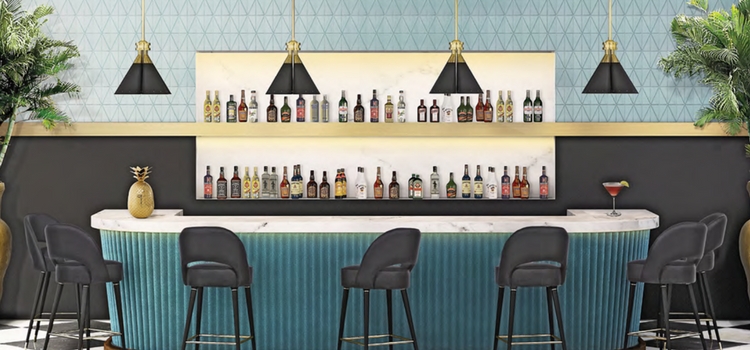
The modern mid-century style never seems to go out of fashion; constantly reinvented, yet always true to its form
Text: DelightFULL Photos: DelightFULL and Essential Home
Think back to the mid 20th century. Think back to the time when Hollywood glamour was at its peak and all the movie and jazz stars such as Marilyn Monroe, Frank Sinatra, Etta James and many more were living the life in California. It was around that time that what we now know as midcentury modern design and architecture first saw the light of day. But, what is mid-century modern design, after all?
Tracing the Movement
Mid-century modern design is an architecture and interior design movement that began in the late 30’s with grand names leading the way. Architects such as Eero Saarinen, Ludwig Mies van der Rohe, and Oscar Niemeyer, as well as nordic product designers like Arne Jacobsen and Charles and Ray Eames are just some of the names that helped make this style one of the most acclaimed in the world. To help you picture it, these designers conceptualized and delivered some of the most iconic mid-century furniture pieces of the modern world like the Egg Chair, all of Ray Eames chairs and his timeless Eames Lounge Chair and Ottoman duo. You might be very familiar with one of Eames’ designs, seeing as it is one of the most famous chairs of all times, used in multiple interior design projects featuring various styles.
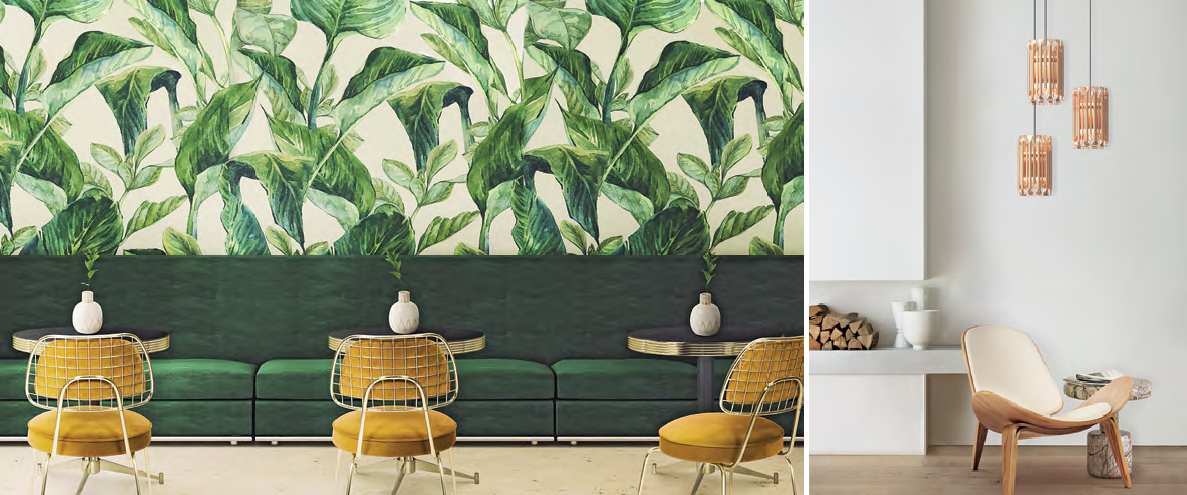
And, of course, you have heard about Palm Springs before. But what does this desert and retro part of California have to do with the midcentury movement? Well, think of Palm Springs as the sacred place for mid-century modern architecture. If you were on a journey to find the best and most iconic architectural examples of this style, then one of the mandatory stops would definitely be Palm Springs. Examples of 1950s Palm Springs mid-century modern architecture include Frank Sinatra’s house by E. Stewart Williams and Kaufmann Desert House. However, you can find many more examples of this style across the US, such as the Farnsworth House in Chicago, and even some more in Europe. Although in a smaller scale, in Europe the mid-century modern movement rose thanks to the influence of Le Corbusier and the scandinavian architects that were in vogue at the time. As you are realizing by now, this an artistic movement that although inspired by many of the scandinavian and nordic design movements happening at the time, it gained its core strength in American soil, walking up to becoming one of the most popular interior design and architecture styles of all times. And, in spite of it having been conceived in the 20th century, this design movement didn’t see its end at the time. Instead, it made its way through the years, gaining more and more followers as the years went by, reaching a point of absolute admiration in the current years. So, one of the best questions we can ask ourselves at this point is, which are the main traits we should be expecting to find when looking for a mid-century interior design project?
Characteristic traits
First of all, look for solid woodwork. Teak, oak and chestnut are the most popular types of wood when it comes to mid-century design. You will find it in cabinets, sideboards and in many different types of upholstery items. You will also notice how all the sofas, accent chairs, ottomans and stools will have either wooden details or a golden brass finish, creating a nordic vibe mixed with all the Hollywood glamour we are used to.
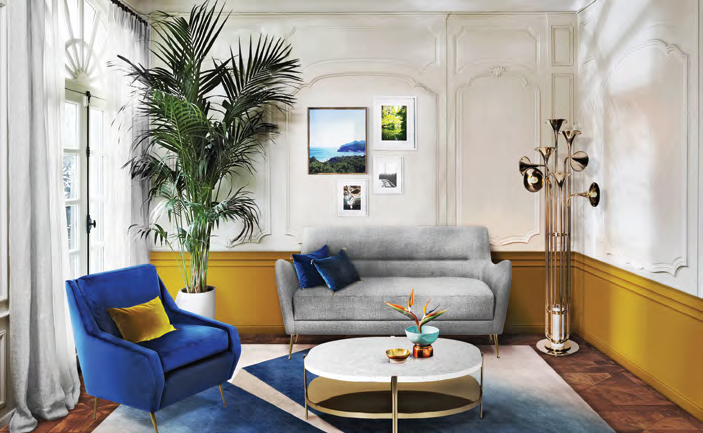
Strong and bold colors are also a very important characteristic of this style. When you think midcentury design, you will inevitably think about bold colors such as tangerine, avocado, mustard and pretty much any powerful colors that have ever existed. Neutral shades were replaced by an explosion of color that helped shape the rooms and give them a whole new life.
Another thing that clearly sets this style apart is the use of simple and uncomplicated lines everywhere. The designers embraced the motto ‘less is more’, thus creating clean-lined furniture with a few curves and smooth surfaces that were paired up to create minimalist interiors, as opposed to the pre-existing maximalism trend.
Finally, you have to look for textures and patterns. You will see that every mid-century modern interior features some kind of statement texture or pattern, which can either be a shag rug, a geometric patterned wallpaper, or even a ceramics or aluminum lighting piece. Which takes us right to the next topic on this journey through mid-century design…
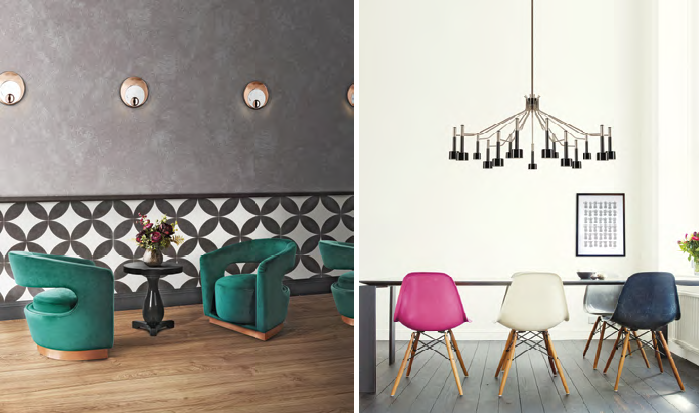
There is a particular mid-century and retro chic interior design brand that uses oak and chestnut woods in the most wonderful way, creating authentic mid-century designs, inspired by the golden Hollywood years. Essential Home’s pieces are also colorful, exuding an elegant and playful vibe, with clean lines, graceful curves and textures such as velvet that are a homage to the 50s, 60s and 70s. All in all, Essential Home is the personification of ‘glamour meets mid-century design’, with many oak details, as well as brass with golden and copper finishes, which definitely create a nostalgic feeling towards all the big Hollywood stars’ homes in Palm Springs.
And it shined
Another huge movement that took place by the time mid-century design started to appear and sweep everyone away was the mid-century lighting design movement. Once again, incredible designers shared with the world their iconic pieces. This is when the timeless Arco floor lamp by Achille Castiglioni and the Spider ceiling lamp by Serge Mouille were presented and set new rules and boundaries to the lighting design world. From then on, the world would come to know major mid-century lighting design brands, with inspiration drawn from the classics and some of the biggest icons of the pop culture. One of those brands is DelightFULL. Created in the early 2000’s, DelightFULL set out to be an example and a reference in the mid-century lighting design world. Their designs draw inspiration from the best the mid 20th century had to offer, creating an inspiring and magical feeling that takes us right back to the nostalgic 50s and 60s. With a retro chic feeling to it, channeling the DelightFULL’s high-end trait, two of the brand’s most popular designs include the golden brass saxophone-inspired floor and suspension lamps called Botti.
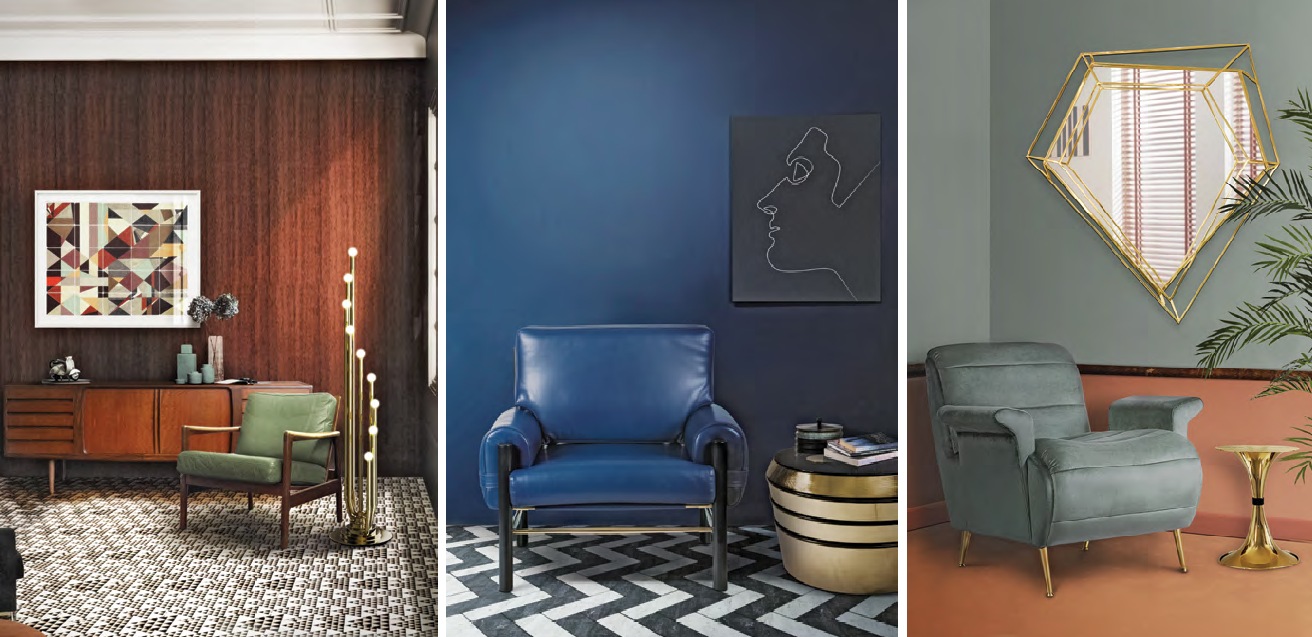
As it is clear by the pictures, DelightFULL takes advantage of the more glamorous side of the midcentury modern design, choosing to play with materials such as brass and aluminum. The brass elements can also be finished in gold, nickel and copper, enabling all mid-century design lovers to achieve the best and most customized look they can think of for their homes. Additionally, materials such as marble are also featured in many of the brand’s designs, which only comes to show the importance of textures and materials in the mid-century modern design world.
Nothing in a mid-century modern interior design is done by chance, and although it may seem quite a minimalist and simple style, the truth is, details are everywhere and they are a very important part of the complete look. So, keep in mind that this is a style that has still much more to give and it is definitely here to stay and inspire everyone!
Digital Version: https://goo.gl/Bs9vlq
Architecture
Creating a Cozy Living Room: Tips for Comfort and Style
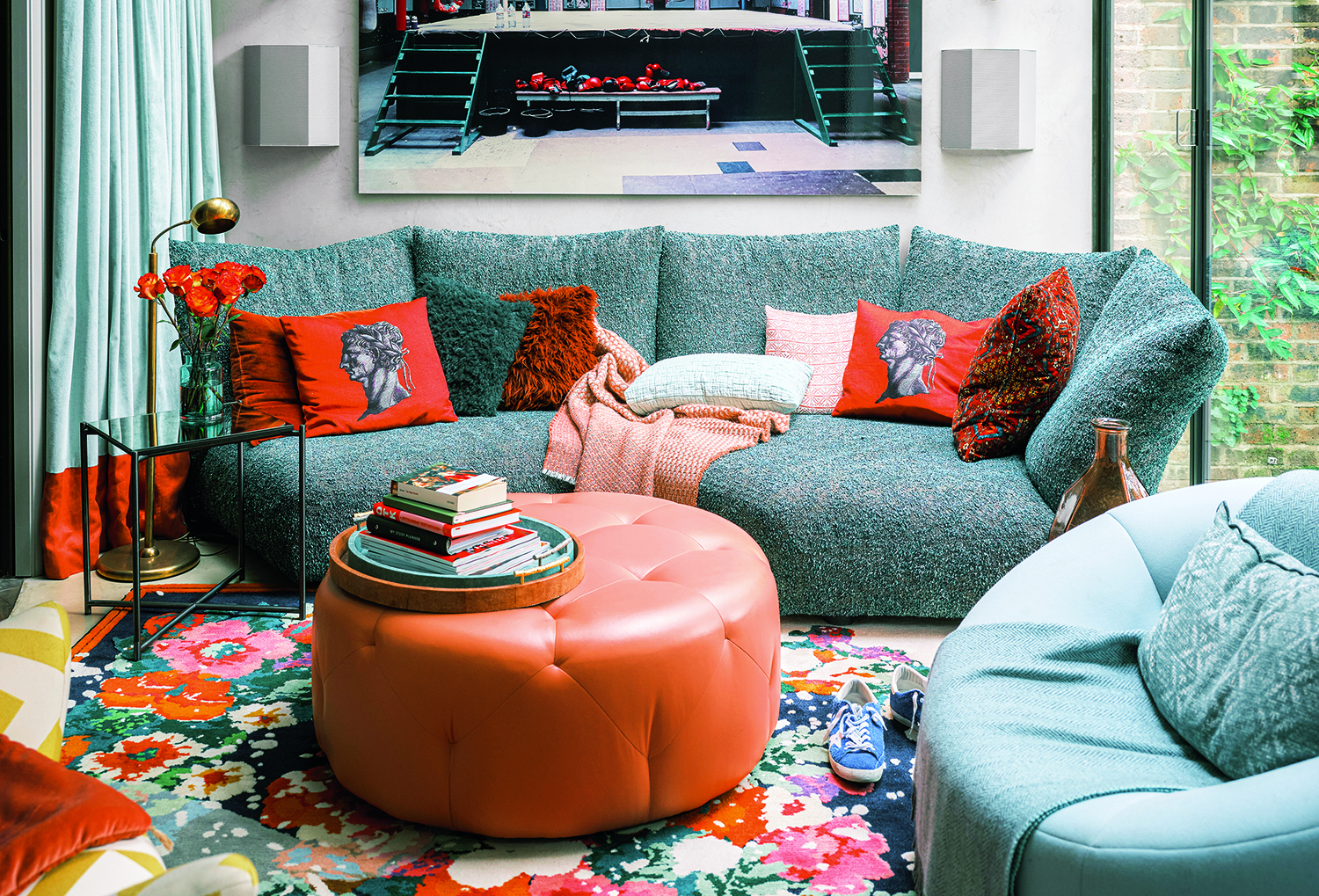
Your living room is more than just a space for entertaining; it’s a sanctuary where you unwind, relax, and spend quality time with loved ones. Creating a cozy living room involves a blend of comfort and style that makes the space inviting and functional. Here are some tips to help you achieve that perfect balance:
Choose the Right Furniture
Start with furniture that combines comfort and functionality. Opt for a plush sofa with deep cushions, perfect for lounging. Consider adding a cozy armchair or a recliner for additional seating. Make sure the furniture arrangement promotes conversation and allows for easy movement throughout the room.
Layer Your Lighting

Lighting plays a crucial role in setting the mood. Use a mix of lighting sources to create a warm ambiance. Combine overhead lights with floor lamps, table lamps, and wall sconces. For added coziness, incorporate dimmers or smart bulbs that let you adjust the brightness to suit different times of day and activities.
Add Textures with Throws and Pillows
Textures are key to a cozy living room. Layer different fabrics, such as soft throw blankets, plush pillows, and textured rugs. Choose fabrics like wool, velvet, and cotton that add warmth and comfort. Mix and match patterns and colors to create visual interest and a personalized touch.
Incorporate Warm Colors
Color influences the feel of a room. Opt for warm, neutral tones like beige, taupe, or soft gray for a calming effect. Accents in rich colors like deep blues, earthy greens, or warm terracotta can add depth and coziness. Use these colors in your furniture, accessories, and wall decor.
Use Rugs to Define Spaces
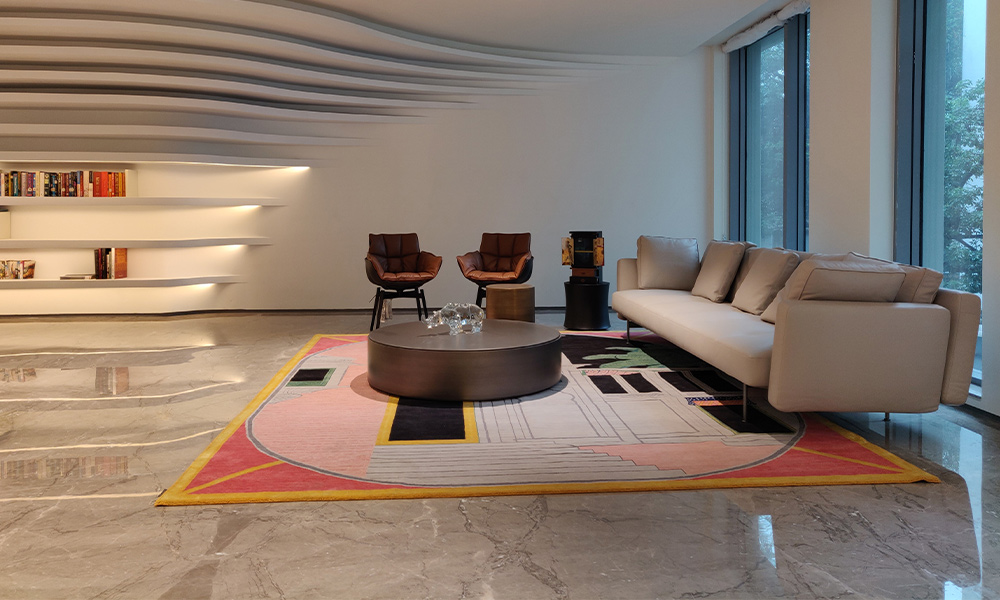
Rugs can help define different areas within a living room and add a layer of warmth underfoot. Choose a rug that complements your furniture and adds softness to the space. A large area rug can anchor the room, while smaller rugs can be used to highlight specific areas, like a reading nook or conversation zone.
Incorporate Natural Elements
Bring the outdoors in by incorporating natural elements. Plants not only add a touch of greenery but also improve air quality and create a calming atmosphere. Choose low-maintenance plants like succulents or snake plants if you’re not an avid gardener. Wooden furniture or decor pieces can also add a natural, grounded feel to the room.
Personalize with Artwork and Décor
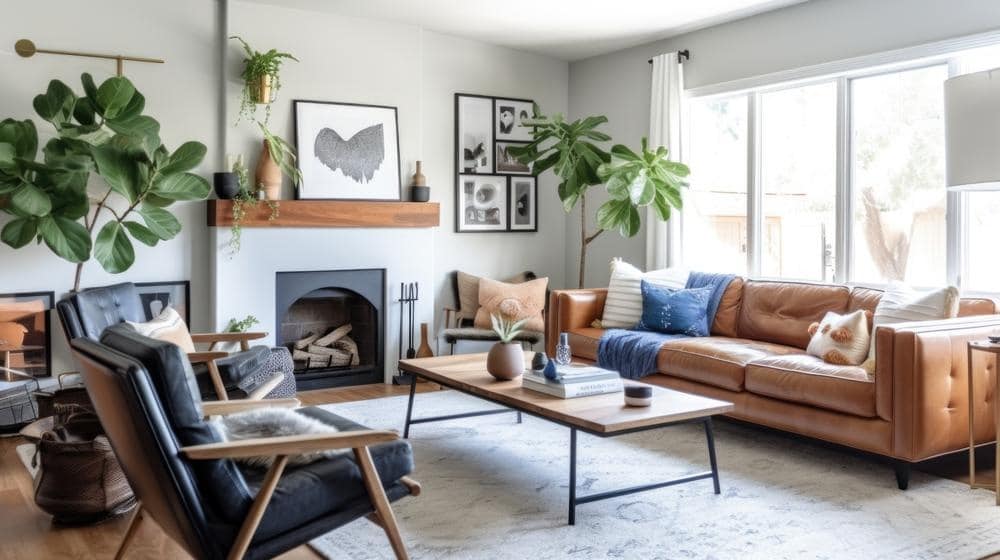
Add personality to your living room with artwork and decorative items that reflect your style. Choose pieces that resonate with you, whether it’s family photos, abstract art, or vintage finds. Arrange decor items in groups to create visual interest and avoid clutter.
Create a Focal Point
A focal point helps draw the eye and creates a sense of balance in the room. This could be a fireplace, a statement piece of art, or a stylish coffee table. Arrange your furniture and decor around this focal point to enhance the room’s overall cohesion and appeal.
Invest in Quality Window Treatments
Window treatments can impact both the look and feel of your living room. Opt for curtains or blinds that provide privacy while allowing natural light to filter through. Choose fabrics that complement your decor and add texture, such as linen or velvet.
Add Personal Touches

Finally, make the space truly yours by adding personal touches. Incorporate items that have sentimental value or reflect your interests and hobbies. Whether it’s a collection of travel souvenirs, a beloved quilt, or unique decorative objects, these elements will make your living room feel more inviting and personal.
By thoughtfully combining these elements, you can create a cozy living room that serves as a comfortable retreat and a stylish gathering place for friends and family. Enjoy the process of making your space uniquely yours and revel in the comfort and warmth it provides.
Architecture
The Art of Feng Shui: Creating Harmony in Your Home

Feng Shui, an ancient Chinese art and science, is all about creating harmony and balance in our living spaces. By arranging our homes in accordance with Feng Shui principles, we can invite positive energy, known as “chi,” into our lives and promote health, wealth, and happiness. In this blog post, we’ll explore the fundamentals of Feng Shui and share practical tips for applying its principles to create a harmonious and inviting home environment.
Understanding the Basics of Feng Shui:
Feng Shui is based on the concept of “chi,” or life force energy, which flows through our environments and influences our well-being. The goal of Feng Shui is to create a harmonious flow of chi by arranging our surroundings in a way that promotes balance and harmony. This includes paying attention to the layout, orientation, and organization of our homes to optimize the flow of energy.
The Five Elements of Feng Shui:
In Feng Shui, there are five elements—wood, fire, earth, metal, and water—that represent different qualities and energies. By incorporating these elements into our home decor, we can create a sense of balance and harmony. For example, wood represents growth and vitality, while water symbolizes flow and abundance. By incorporating a balance of these elements into our living spaces, we can enhance the flow of positive energy and create a sense of equilibrium.
Applying Feng Shui Principles to Your Home:
Clearing Clutter: Clutter can block the flow of chi and create stagnant energy in our homes. Start by decluttering your space and getting rid of items that no longer serve a purpose. This will create space for fresh energy to flow and rejuvenate your home.
Balancing Yin and Yang: In Feng Shui, yin and yang represent the balance of feminine and masculine energies. Create a harmonious balance of yin and yang in your home by incorporating soft, nurturing elements (yin) with strong, active elements (yang).
Enhancing the Flow of Chi: Pay attention to the layout and arrangement of furniture in your home to optimize the flow of chi. Avoid placing furniture in direct line with doorways or blocking pathways, as this can disrupt the flow of energy. Instead, create open and inviting spaces that allow chi to circulate freely.
Incorporating Nature: Bring the outdoors in by incorporating elements of nature into your home decor. Plants, natural materials, and natural light can enhance the flow of chi and create a sense of vitality and well-being in your living spaces.
Room-By-Room Feng Shui Tips:
Living Room: Arrange furniture in a circular or semi-circular layout to encourage conversation and social interaction. Use soft, natural fabrics and incorporate elements of wood and fire to create warmth and intimacy.
Bedroom: Position your bed diagonally across from the door to command a clear view of the room while you sleep. Keep the space under your bed clear and clutter-free to promote restful sleep and relaxation.
Kitchen: Keep your kitchen clean, organized, and clutter-free to promote health and abundance. Incorporate elements of fire and earth, such as candles and earthy tones, to create a warm and inviting atmosphere for cooking and dining.
By incorporating the principles of Feng Shui into your home decor, you can create a harmonious and balanced living environment that supports your health, happiness, and overall well-being. Whether you’re decluttering your space, balancing yin and yang energies, or enhancing the flow of chi, the art of Feng Shui offers timeless wisdom and practical guidance for creating a sanctuary of peace and tranquility in your home.
Architecture
5 Sustainable Interior Design Trends to Embrace in 2024

As the world becomes increasingly aware of the importance of sustainability, it’s no surprise that eco-friendly practices are making their way into the realm of interior design. In 2024, we can expect to see a surge in sustainable interior design trends that not only enhance the beauty of our living spaces but also minimise our environmental footprint. From repurposed materials to energy-efficient solutions, here are five sustainable interior design trends to embrace this year.
Upcycled Furniture:

One of the most prominent sustainable interior design trends of 2024 is the use of upcycled furniture. Instead of buying new pieces, consider giving old furniture a new lease on life by refurbishing or repurposing them. From reclaimed wood tables to refurbished chairs, upcycled furniture adds character and charm to your space while reducing waste and conserving resources.
Biophilic Design:

Biophilic design, which emphasizes a connection to nature, continues to gain popularity in 2024. Integrating natural elements such as plants, natural light, and organic materials into your interior design not only enhances aesthetics but also promotes well-being and sustainability. Consider incorporating living walls, indoor gardens, and sustainable wood finishes to bring the outdoors inside and create a healthier living environment.
Energy-Efficient Lighting:

With a growing focus on energy conservation, energy-efficient lighting solutions are becoming a staple in sustainable interior design. LED lights, in particular, consume significantly less energy than traditional incandescent bulbs and last much longer, reducing both energy consumption and maintenance costs. Additionally, consider incorporating natural light sources such as skylights and large windows to maximize daylight and minimize the need for artificial lighting during the day.
Sustainable Textiles:

When it comes to upholstery and soft furnishings, opting for sustainable textiles is key to reducing environmental impact. Look for fabrics made from organic or recycled materials, such as organic cotton, hemp, bamboo, or recycled polyester. These materials not only reduce the use of harmful chemicals and pesticides but also minimize waste and support eco-friendly production practices. Additionally, consider investing in durable, high-quality textiles that stand the test of time, reducing the need for frequent replacements.
Smart Home Technology:

In 2024, smart home technology continues to evolve, offering innovative solutions for sustainable living. From smart thermostats that optimize energy usage to home automation systems that control lighting and appliances, these technologies can help reduce energy consumption and increase efficiency in your home. Additionally, smart home devices such as occupancy sensors and smart meters provide valuable insights into your energy usage, empowering you to make informed decisions about resource management and conservation.
As we strive to create more sustainable living environments, embracing these five interior design trends can help reduce our environmental impact while creating beautiful and functional spaces. Whether you’re upcycling old furniture, incorporating natural elements, or investing in energy-efficient technologies, every sustainable choice contributes to a greener future for generations to come. So let’s embrace these trends and make sustainability a cornerstone of our interior design practices in 2024 and beyond.
-

 Style11 months ago
Style11 months agoBridal Guide : Best Looks of Radhika Merchant Ambani
-

 Entertainment1 year ago
Entertainment1 year agoThe Stunning looks from Bhagya Suresh’s Wedding
-

 Fashion1 year ago
Fashion1 year agoMost Discussed Ajrakh Saree of Alia Bhatt
-

 Entertainment1 year ago
Entertainment1 year agoThe Most Stylish Guests of Bhagya Suresh Reception
-

 Entertainment1 year ago
Entertainment1 year agoBridal Bliss : All Bridal Looks of Swasika Vijay
-

 Movies1 year ago
Movies1 year agoA Nostalgic Journey Through Love &Cinema : Best Bollywood Romantic 90s Movies
-

 Fashion1 year ago
Fashion1 year agoMajor Denim Trends You Need To Know in 2024
-

 AD8 months ago
AD8 months agoPopular Curtain Fabrics to Consider for Your Home


































